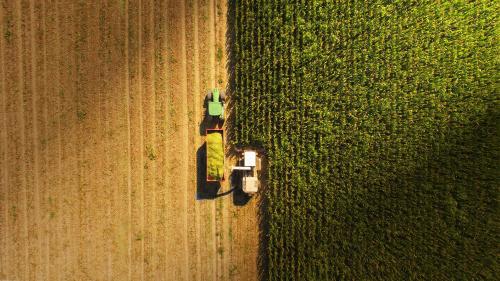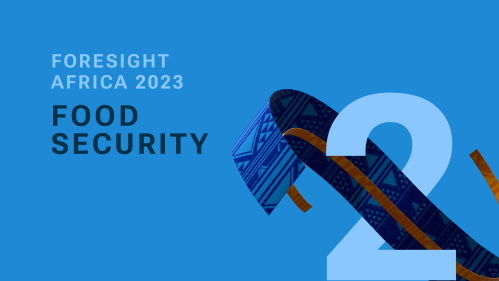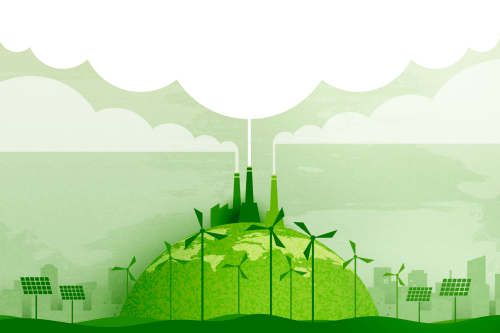July 24 to 26, 2023, in Rome, U.N. Secretary-General António Guterres will convene a U.N. Food Systems Stocktaking Moment, the first global follow-up to the 2021 Food Systems Summit. The event will provide opportunities for nations to review commitments made during the summit and share success stories and evidence of transformation. Africa will likely be in the spotlight in the search for progress in ending hunger, improving food security, and building resilience in the face of climate change.
Almost two decades ago, on the fringes of an African Union Summit in Addis Ababa, then-U.N. Secretary-General Kofi Annan, delivered a clarion call to action on ending hunger in Africa:
“We are here together to discuss one of the most serious problems on earth: the plague of hunger that has blighted hundreds of millions of African lives—and will continue to do so unless we act with greater purpose and urgency.”
In his Addis Ababa speech, delivered on July 5, 2004, Annan noted the vulnerability of African small-holder farmers to climate shocks and declining soil fertility, acknowledging that the scientific breakthroughs obtained in Asia could not be directly applied to Africa. Drawing on the work of the U.N Millennium Project Hunger Task Force, Annan called for a different kind of green revolution—a more holistic approach that would include small-scale irrigation, improvements in soil health, and complementary investments in infrastructure and social safety nets.
“Let us generate a uniquely African green revolution—a revolution that is long overdue, a revolution that would help the continent in its quest for dignity and peace.”
The “World Development Report 2008,” drawing on statistics up to 2004, noted that Asia’s green revolution breakthrough in cereals had not reached sub-Saharan Africa. This lagging performance was attributed to several factors including high dependence on rainfed agriculture, wide diversity of staple food crops, poor infrastructure, policy discrimination against agriculture, and low public and private investment. Fertilizer use—a key contributor to Asia’s green revolution success—was just 12 kilograms per hectare in sub-Saharan Africa in 2004, less than one-tenth of the application levels in Asia at that time.
Malawi was one of the first countries to take up Annan’s challenge. Controversially, against the advice of its most powerful donors, Malawi’s President Bingu wa Mutharika subsidized inputs through a government-funded voucher scheme known as the Farm Input Subsidy Program (FISP). Millions of small-holder farmers received fertilizer and improved seed at a fraction of the market price.
With good rains and a strong response to subsidized fertilizer and improved seeds, national maize production doubled in 2006. Critics argued Mutharika struck it lucky with the weather, and that these results could not be sustained. However, despite changes in national leadership and stop-start support from Malawi’s donors, the FISP has continued as a strategy for increasing farm productivity and national food security. The results are impressive. Since 2005, Malawi’s farmers have generated surpluses over national requirements in all but three years—2015, 2016, and 2018 (Figure 1).
Figure 1. Maize production and consumption requirements in Malawi, 1961-2021
Source: Denning (2023) Universal Food Security: How to End Hunger While Protecting the Planet. p. 188
Notes: Data from FAOSTAT.
National maize production increased by 79 percent between 2004 and 2019 (comparing averages for 2002-2004 and 2017-2019). This increase was the product of a 62 percent increase in average yield and 10 percent increase in harvested area. As a country with limited land resources and a high population density, Malawi’s increase in maize production mirrored the experience of Asia, demonstrating that it was possible to intensify existing cultivated land under rainfed conditions. And it should be recognized that productivity improvements in Asia were dependent on significant government support by way of inputs and credit subsidies, market support prices, and aggressive extension campaigns.
Since its inception in 2005, the case of input subsidies in Malawi and elsewhere in sub-Saharan Africa has been a source of heated debate. There is no doubt that FISP enabled agricultural intensification and has increased overall food availability in Malawi. Small-holders in Malawi have two basic resources to draw upon for their household food security in a tough production environment: their land and their labor. Fertilizer and improved seed increased the productivity of both. With little scope to expand the land frontier in Malawi, the only solution was intensification of existing land.
A broader comparison of sub-Saharan Africa and Asia reveals unexpected parallels (Figure 2). With the baseline of 2004—the year of Kofi Annan’s call for a “uniquely African green revolution”—cereal production in 2019 across sub-Saharan Africa had increased by 76 percent. Taking the baseline for Asia’s green revolution as 1966—the year the “miracle rice” variety IR8 was released—the comparable production increase was 62 percent. While Asia’s increase came almost entirely through yield per hectare, the increases in sub-Saharan Africa came from a combination of area expansion (53 percent) and yield (27 percent).
Figure 2. Increase in cereal production in sub-Saharan Africa and Asia during the first fifteen years of the green revolutions in each region. (2004-2019 and 1966-1981, respectively).
Source: Denning (2023) Universal Food Security: How to End Hunger While Protecting the Planet. p. 45
Notes: Data from FAOSTAT.
Despite these encouraging results from Malawi and sub-Saharan Africa as a whole, it would be premature to declare “mission accomplished.” Most African countries continue to import food, a reality laid bare by the disruptions of supply chains caused by COVID-19 and the Russian invasion of Ukraine. Population growth, urbanization, and shifting diets will continue to create challenges and opportunities for small-holder farmers across the continent. Sub-Saharan Africa accounts for a fifth of the world’s human-induced land degradation, according to the Food and Agriculture Organization (FAO). There will be continued pressures to advance the land frontier through deforestation with consequent biodiversity losses and increased greenhouse gas emissions. Buoyed by the progress of the past 15 years and the need to halt land degradation, there is a compelling case for a Phase 2 of Kofi Annan’s uniquely African green revolution. And the core strategy for Phase 2 should be sustainable intensification, a strategy in aggregate whereby combinations of the following actions are implemented in national and local context.
- Increase output on existing farms through increased use of external inputs, such as improved seed, inorganic and organic fertilizer, and irrigation. The case of Malawi is an example of such action, noting that even with FISP, current national maize yields are just 2 tons per hectare compared with 7 tons per hectare.
- Maintain current farm output levels, but with a reduced environmental footprint through more efficient input use. Examples include the development and extension of more precise fertilizer recommendations, promotion of fertilizer-blending facilities, and increased use of higher-yielding locally adapted varieties that make the best use of improved soil fertility.
- Restore abandoned and unproductive lands through strategic use of critical external inputs such as inorganic and organic fertilizer, crop and fodder legumes as intercrops and in rotation, agroforestry, water harvesting, and well-adapted crop types and varieties.
- Abandon annual cropping of some unproductive lands and develop more sustainable, alternative enterprises including forestry, agroforestry, and managed grazing systems. On these lands, carbon farming should be considered as a source of income.
- Reduce postharvest losses in storage, transport, processing, and marketing, thereby generating more net food supply from the land.
- Protect remaining natural ecosystems and ensure valuation and compensation for the environmental services (e.g., biodiversity compensation, carbon retention, and water and soil conservation) that they provide.
These actions will be most effective when coupled with investments in market infrastructure and business-friendly policies to ensure that surpluses above consumption requirements can be marketed profitably to consumers. Investment in transport infrastructure, electrification, and digital information and communication systems are essential complementary investments for sustainable intensification.
The case for a uniquely African green revolution is more compelling than ever. In Asia, important lessons were learned in the first phase of its green revolution. The second phase of Asia’s green revolution was more nuanced, more inclusive, more sustainable, and more productive. The U.N. Food Systems Stocktaking Moment this July provides an important opportunity for African nations to reflect on and prepare for Phase 2 of Kofi Annan’s uniquely African green revolution.
Disclaimer: The author has drawn extensively on Denning (2023) Universal Food Security: How to End Hunger While Protecting the Planet (Columbia University Press).
The Brookings Institution is committed to quality, independence, and impact.
We are supported by a diverse array of funders. In line with our values and policies, each Brookings publication represents the sole views of its author(s).










Commentary
Sustainable intensification in aggregate: Phase 2 of Kofi Annan’s uniquely African green revolution
April 27, 2023